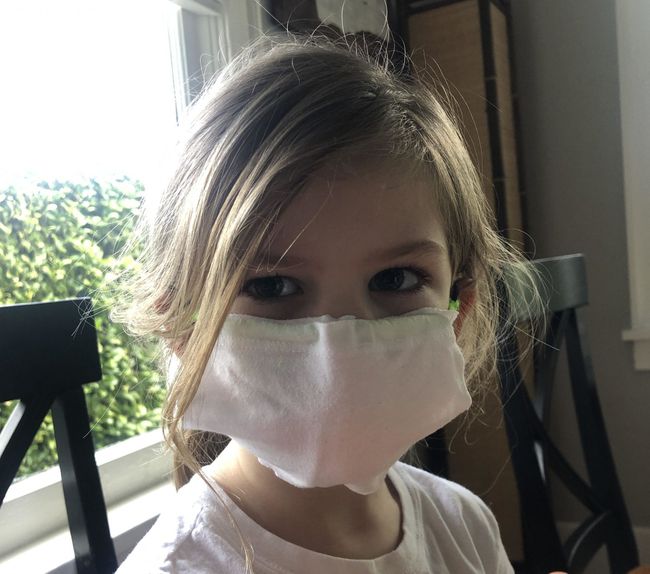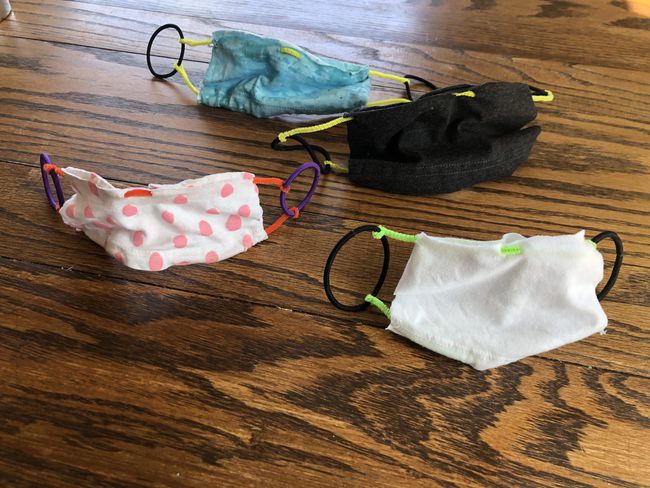It's hard not to feel particularly dystopic when suggesting that parents make coronavirus masks for kids as a family arts and crafts project, but these are unprecedented times. And official recommendations for wearing face masks to slow the spread of COVID-19 have continued to evolve since the start of the pandemic.
In February 2022, the Centers for Disease Control and Prevention (CDC) updated its mask guidance yet again, sharing recommendations based on what it calls COVID-19 community levels. The metric is calculated for each county in the U.S., based on factors like the number of new COVID-19 hospital admissions and total new COVID-19 cases.
In areas where the community level is classified as “high,” for example, the CDC recommends that people over the age of 2 wear a well-fitting face mask when indoors in public spaces, regardless of their vaccination status.
Though your county's community level and the CDC's recommendations are a great place to start, experts emphasize that even if face masks aren't required, you should feel free to continue to wear a mask according to your personal preference and your family's level of risk. Having several mask options on hand—both disposable and reusable—has become a common strategy for many families.

Why Wear a Mask
"Masks aren't just to protect yourself, but others," explains Rick Wu, M.D., a prominent anesthesiologist in Taiwan who has worked on the country's successful treatment and containment of the coronavirus. "If you cough, it will spread," he says. "If you have a mask on, you can save others, even your family, from the droplets that spread the virus."
While the CDC confirms that commercial products such as procedural (aka surgical) masks and N95 and KN95 respirators are among the most effective types of masks for preventing the spread of the coronavirus, supply was less than steady in the early days of the pandemic. Though these options are much more readily available now, homemade cloth masks can still have their place.
In fact, the CDC is quick to remind Americans that “any mask is better than no mask.” And scientific research still supports the use of well-fitting multi-layer cloth masks for limiting COVID-19 transmission, even if they aren’t the most effective option.
This guide will show you how to make fitted face masks for kids and adults from just an old T-shirt and a few household craft supplies—no sewing machine required. Keep these masks in the car or in your bag as backups for more protective masks when you and your kids are out and about in lower-risk situations.

What You Need to Make a Mask
- Cotton T-shirt (ideally one that is tightly woven with a high thread count)
- Pipe cleaners
- Elastic hair ties
How to Make a No-Sew Mask
- Measure a rectangle that is 7 inches (6 inches for a child's mask) long along the bottom hem of the T-shirt and 4 inches tall. Cut the shape out of both layers (front and back) of the T-shirt.
- Flip the front piece vertically, so that the hem is at the top.
- In the front piece, poke two tiny holes like a snake bite in the center underside of the hemming—the piece that will face the back layer of fabric. Then poke two matching ones in the back layer of fabric.
- Poke two more holes, one in each upper corner of the back layer.
- Thread one pipe cleaner through the corner hole and then into the hem. When you get to the snake bite hole, push the pipe cleaner out and weave it through the holes in the back layer, then back in the other side. Continue through to the far edge, then weave it out through the back corner hole.
- Repeat the process with two corner holes and the snake bite in the center with the bottom edge hem.
- Fix the hair bands to the ends of both the bottom and top by twisting the pipe cleaners around them, one on each side.
- Fit the mask to your or your child's face by pressing the top pipe cleaner gently over the nose so that it hugs as tightly as possible. Adjust the length using the pipe cleaner as needed.
When selecting an old T-shirt for this project, it's important to find one with a tight weave and high thread count. To test this, hold the fabric up to a bright light source. You want a fabric that blocks as much light as possible to provide the best protection from respiratory particles.
To check the fit of the mask, ensure that it is well-fitted around the nose, mouth, and chin to prevent leaks. The pipe cleaner will help hold the mask tight to the face.
Once your masks are made and worn, wash them after each use. You can wash cloth masks by hand with plenty of hot water and soap or machine wash in a delicates bag on gentle.
Why You Should Have Your Kids Help
Having the kids help make these washable face masks, as if it were any other arts and crafts project, gives them a little more buy-in to the project and uses materials that they're familiar with.
Kids are smart and they pick up on little changes, explains Seattle pediatrician Annie Weisner, M.D., Ph.D. Having them help with making the mask “directly engages with the changes they’re dealing with in a way that has positivity and empowerment.” Encourage them to pick a favorite old T-shirt to use for the project to get them excited to wear it.
And even though homemade masks are less effective than the kind Dr. Weisner wears at the hospital, she says the protection they offer is "a lot more than zero."
As far as getting kids to wear the masks? "Make sure it's comfortable," advises Dr. Weisner. Check that it is fitted but doesn't put undue pressure on the backs of the ears and that the ends of the pipe cleaners are tucked in so they don't scratch.
If it's not comfortable, it's more likely that they will fiddle with the mask, which negates the usefulness; part of the idea of the mask is that they touch their face less, not more. Some kids might be too young for that, but Dr. Weisner says even preschool-age kids will want to do whatever their older siblings or parents are—so it's up to you to set the example.
